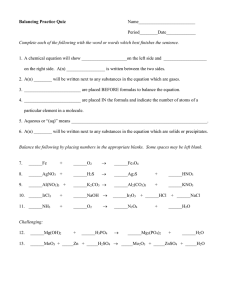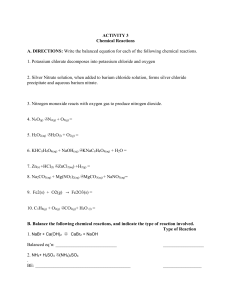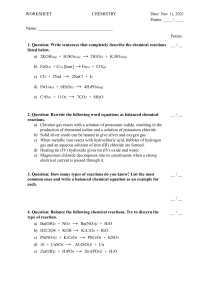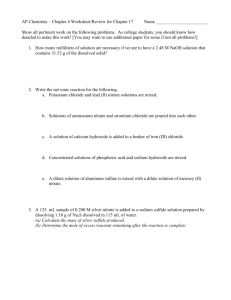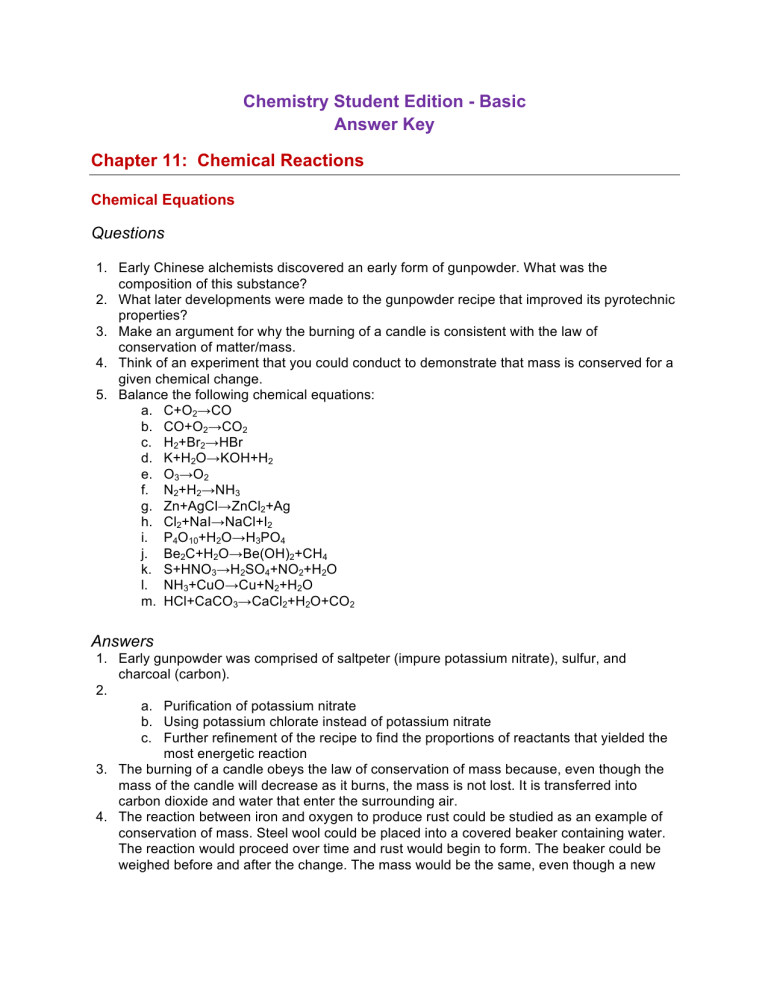
Chemistry Student Edition - Basic Answer Key Chapter 11: Chemical Reactions Chemical Equations Questions 1. Early Chinese alchemists discovered an early form of gunpowder. What was the composition of this substance? 2. What later developments were made to the gunpowder recipe that improved its pyrotechnic properties? 3. Make an argument for why the burning of a candle is consistent with the law of conservation of matter/mass. 4. Think of an experiment that you could conduct to demonstrate that mass is conserved for a given chemical change. 5. Balance the following chemical equations: a. C+O2→CO b. CO+O2→CO2 c. H2+Br2→HBr d. K+H2O→KOH+H2 e. O3→O2 f. N2+H2→NH3 g. Zn+AgCl→ZnCl2+Ag h. Cl2+NaI→NaCl+I2 i. P4O10+H2O→H3PO4 j. Be2C+H2O→Be(OH)2+CH4 k. S+HNO3→H2SO4+NO2+H2O l. NH3+CuO→Cu+N2+H2O m. HCl+CaCO3→CaCl2+H2O+CO2 Answers 1. Early gunpowder was comprised of saltpeter (impure potassium nitrate), sulfur, and charcoal (carbon). 2. a. Purification of potassium nitrate b. Using potassium chlorate instead of potassium nitrate c. Further refinement of the recipe to find the proportions of reactants that yielded the most energetic reaction 3. The burning of a candle obeys the law of conservation of mass because, even though the mass of the candle will decrease as it burns, the mass is not lost. It is transferred into carbon dioxide and water that enter the surrounding air. 4. The reaction between iron and oxygen to produce rust could be studied as an example of conservation of mass. Steel wool could be placed into a covered beaker containing water. The reaction would proceed over time and rust would begin to form. The beaker could be weighed before and after the change. The mass would be the same, even though a new substance was created, thereby demonstrating that mass is conserved in a chemical process. 5. a. b. c. d. e. f. g. h. i. j. k. l. m. 2 C+O2→ 2 CO 2 CO+O2→ 2 CO2 H2+Br2→ 2 HBr 2 K+2 H2O→2 KOH+H2 2 O 3→ 3 O 2 N2+3 H2→2 NH3 Zn+2 AgCl→ZnCl2+2 Ag Cl2+2 NaI→2 NaCl+I2 P4O10+6 H2O→4 H3PO4 Be2C+4 H2O→2 Be(OH)2+CH4 S+6 HNO3→H2SO4+6 NO2+2 H2O 2 NH3+3 CuO→3 Cu+N2+3 H2O 2 HCl+CaCO3→CaCl2+H2O+CO2 Types of Chemical Reactions Questions 1. Categorize the following chemical reactions as single replacement, double replacement, combustion, combination, or decomposition. a. Equimolar (having the same number of moles) solutions of silver nitrate and potassium chloride are mixed to produce solid silver chloride and aqueous potassium nitrate. b. Magnesium metal is added to hydrochloric acid to produce hydrogen gas and aqueous magnesium chloride. c. Ethanol is burned in air to produce water and carbon dioxide gas. d. Water is electrolyzed to produce hydrogen and oxygen gas. e. Hydrogen gas and oxygen gas are ignited to produce water. 2. Write the balanced chemical equation for the following combination and decomposition reactions. a. Magnesium carbonate is heated strongly to produce magnesium oxide and carbon dioxide gas. b. Hydrogen peroxide decomposes to produce water and oxygen gas. c. Solid potassium chlorate is heated in the presence of manganese dioxide as a catalyst to produce potassium chloride and oxygen gas. (Catalysts speed up reactions but are not expressed in the overall balanced equation) d. Molten aluminum oxide is electrolyzed using inert (non-reactive) electrodes to produce aluminum metal and oxygen gas. 3. Write the balanced chemical equations for the following replacement reactions: a. Zinc metal is added to a solution of iron(II) sulfate. b. Equimolar solutions of lead(II) nitrate and sodium chloride are mixed to produce solid lead(II) chloride and aqueous sodium nitrate. c. Solutions of potassium phosphate and zinc nitrate are mixed. 4. Write the balanced chemical equations for the following combustion reactions. a. Propane (C3H8) is ignited in air to produce water and carbon dioxide gas. b. Methanol(CH4O) is ignited in air to produce water and carbon dioxide gas. c. Ethanol (C2H5OH) is burned in air. 5. Write the molecular equation, ionic equation, and net ionic equation for each of the following double replacement reactions. a. Silver nitrate reacts with potassium iodide to produce potassium nitrate and silver iodide. b. Silver nitrate reacts with iron(III) chloride to produce iron(III) nitrate and silver chloride. c. Lead(II) nitrate reacts with potassium iodide to produce potassium nitrate and lead(II) iodide. d. Iron(III) chloride reacts with lead(II) nitrate to produce lead(II) chloride and iron(III) nitrate. e. Calcium chloride reacts with sodium hydroxide to produce calcium hydroxide and sodium chloride. 6. Would it be possible to have a double precipitate formed for a double replacement process? Can you write an equation where a double precipitate forms? 7. What is meant when we describe a compound as (aq) or (s)? Explain the similarities and differences between these terms. 8. Write the balanced chemical equation for the combination reaction in which hydrogen and oxygen gases react explosively to produce water. (Remember that hydrogen and oxygen exist as diatomic gases in their most common elemental form.) 9. Write the balanced chemical equation for the reaction that occurs when a piece of aluminum metal is placed in a solution of silver nitrate. 10. Using the solubility rules given above, predict whether or not the following compounds are soluble or insoluble in water. a. Potassium nitrate b. Lead(II) chloride c. Barium sulfate d. Aluminum sulfide e. Calcium carbonate Answers 1. Categorize the following chemical reactions as single replacement, double replacement, combustion, combination, or decomposition. a. Double Replacement b. Single Replacement c. Combustion d. Decomposition e. Combination 2. Write the balanced chemical equation for the following combination and decomposition reactions. a. MgCO3(s) → MgO(s) + CO2(g) b. 2 H2O2 → 2 H2O + O2 c. 2 KClO!(!) !"!! 2 KCl(!) + 3 O!(!) !"!#$%&"'(!) d. 2 Al! O!(!) 2 Al(!) + 3 O!(!) 3. Write the balanced chemical equations for the following replacement reactions: a. Zn(s) + Fe2SO4(aq) → Fe(s) + ZnSO4(aq) b. Pb(NO3)2(aq) + 2 NaCl(aq) → PbCl2(s) + 2 NaNO3(aq) c. 2 K3PO4(aq) + 3 Zn(NO3)2(aq) → Zn3(PO4)2(s) + 6 KNO3(aq) 4. Write the balanced chemical equations for the following combustion reactions. a. C3H8(g) + 5 O2(g) → 3 CO2(g) + 4 H2O(l) b. 2 CH4O(l) + 3 O2(g) → 2 CO2(g) + 4 H2O(l) c. C2H5OH(l) + 3 O2(g) → 2 CO2(g) + 3 H2O(l) 5. Write the molecular equation, ionic equation, and net ionic equation for each of the following double replacement reactions. a. M: AgNO3(aq) + KI(aq) -> KNO3(aq) + AgI(s) I: Ag+(aq) + NO3-(aq) + K+(aq) + I-(aq) -> K+(aq) + NO3-(aq) + AgI(s) N: Ag+(aq) + I-(aq) -> AgI(s) b. M: 3AgNO3(aq) + FeCl3(aq) -> Fe(NO3)3(aq) + 3AgCl(s) I: 3Ag+(aq) + 3NO3-(aq) + Fe3+(aq) + 3Cl-(aq) -> Fe3+(aq) + 3NO3-(aq) + 3AgCl(s) N: Ag+(aq) + Cl-(aq) -> AgCl(s) c. M: Pb(NO3)2(aq) + 2KI(aq) -> 2KNO3(aq) + PbI2(s) I: Pb2+(aq) + 2NO3-(aq) + 2K+(aq) + 2I-(aq) -> 2K+(aq) + 2NO3(aq) + PbI2(s) N: Pb2+(aq) + 2I-(aq) -> PbI2(s) d. M: 3Pb(NO3)2(aq) + 2FeCl3(aq) -> 3PbCl2(s) + 2Fe(NO3)3(aq) I: 3Pb2+(aq) + 6NO3-(aq) + 2Fe3+(aq) + 6Cl-(aq) -> 3PbCl2(s) + 2Fe3+ + 6ClN: Pb2+(aq) + 2Cl-(aq) -> PbCl2(s) e. M: CaCl2(aq) + 2NaOH(aq) -> Ca(OH)2(s) + 2NaCl(aq) I: Ca2+(aq) + 2Cl-(aq) + 2Na+(aq)+ 2OH-(aq) -> Ca(OH)2(s) +2Na+(aq)+ 2OH-(aq) N: Ca2+(aq) + 2OH-(aq) -> Ca(OH)2(s) 6. One double displacement process where two precipitates are formed is the reaction between solutions of copper (ii) sulfate and barium hydroxide. CaSO4(aq) + Ba(OH)2(aq) →Ca(OH)2(s) + BaSO4 7. The symbol (aq) refers to the state the solid will be in the presence of water. It describes solubility. The symbol (s) as is used in solution chemistry, is describing solubility. It means solid-in-water. Keep in mind that (s) can also be used to describe a substances state under specified chemical conditions. 8. 2 H2 + O2 → 2 H2O 9. Al + 3 AgNO3 → Al(NO3)3 + 3 Ag 10. a. Soluble b. Insoluble c. Insoluble d. Insoluble e. Insoluble

